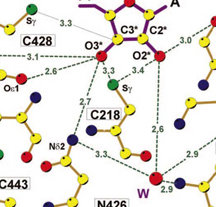University of Tennessee scientists using the Industrial Macromolecular Crystallography Association and BioCARS beamlines at the APS have made a molecular discovery that can greatly improve the medicines used to treat cancer. They made a complete picture of the structure of a critical molecule called RNR that is involved in forming DNA in the cells of all living organisms and then studied how a specific chemotherapy drug interacts with that molecule. "When you have the molecular structure of RNR, you can refine drug molecules to make them more potent and more selective," said UT associate biochemistry professor Chris Dealwis. He is the senior author of two papers appearing in this week's Proceedings of the National Academy of Sciences about the research. PNAS is one of the world's most-cited multidisciplinary scientific publications.
Read the text of the University of Tennessee press release at: https://lightsources.org/cms?pid=1001298
See: H. Xu et al., Proc. Natl. Acad. Sci. USA 103(11), 4022(March 14, 2006); and H. Xu et al., Proc. Natl. Acad. Sci. USA 103(11), 4028 (March 14, 2006.
Argonne National Laboratory is a U.S. Department of Energy laboratory managed by The University of Chicago
The Advanced Photon Source is funded by the U.S. Department of Energy, Office of Science, Office of Basic Energy Sciences

